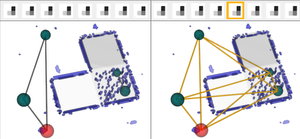Information
- Publication Type: Technical Report
- Workgroup(s)/Project(s):
- Date: May 2016
- Number: TR-186-2-16-2
- Keywords: ensemble visualization, guided local exploration, variance analysis
Abstract
Ensemble datasets describe a specific phenomenon (e.g., a simulation scenario or a measurements series) through a large set of individual ensemble members. These individual members typically do not differ too much from each other but rather feature slightly changing characteristics. In many cases, the ensemble members are defined in 3D space, which implies severe challenges when exploring the complete ensembles such as handling occlusions, focus and context or its sheer datasize. In this paper we address these challenges and put our focus on the exploration of local features in 3D volumetric ensemble datasets, not only by visualizing local characteristics, but also by identifying connections to other local features with similar characteristics in the data. We evaluate the variance in the dataset and use the the spatial median (medoid) of the ensemble to visualize the differences in the dataset. This medoid is subsequently used as a representative of the ensemble in 3D. The variance information is used to guide users during the exploration, as regions of high variance also indicate larger changes within the ensemble members. The local characteristics of the regions can be explored by using our proposed 3D probing widgets. These widgets consist of a 3D sphere, which can be positioned at any point in 3D space. While moving a widget, the local data characteristics at the corresponding position are shown in a separate detail view, which depicts the local outliers and their surfaces in comparison to the medoid surface. The 3D probing widgets can also be fixed at a user-defined position of interest. The fixed probing widgets are arranged in a similarity graph to indicate similar local data characteristics. The similarity graph thus allows to explore whether high variances in a certain region are caused by the same dataset members or not. Finally, it is also possible to compare a single member against the rest of the ensemble. We evaluate our technique through two demonstration cases using volumetric multi-label segmentation mask datasets, two from the
industrial domain and two from the medical domain.
Additional Files and Images
Additional images and videos
Additional files
Weblinks
No further information available.
BibTeX
@techreport{TR1862162,
title = "Visual Analysis of Volume Ensembles Based on Local Features",
author = "Johanna Schmidt and Bernhard Fr\"{o}hler and Reinhold
Preiner and Johannes Kehrer and Eduard Gr\"{o}ller and
Stefan Bruckner and Christoph Heinzl",
year = "2016",
abstract = "Ensemble datasets describe a specific phenomenon (e.g., a
simulation scenario or a measurements series) through a
large set of individual ensemble members. These individual
members typically do not differ too much from each other but
rather feature slightly changing characteristics. In many
cases, the ensemble members are defined in 3D space, which
implies severe challenges when exploring the complete
ensembles such as handling occlusions, focus and context or
its sheer datasize. In this paper we address these
challenges and put our focus on the exploration of local
features in 3D volumetric ensemble datasets, not only by
visualizing local characteristics, but also by identifying
connections to other local features with similar
characteristics in the data. We evaluate the variance in the
dataset and use the the spatial median (medoid) of the
ensemble to visualize the differences in the dataset. This
medoid is subsequently used as a representative of the
ensemble in 3D. The variance information is used to guide
users during the exploration, as regions of high variance
also indicate larger changes within the ensemble members.
The local characteristics of the regions can be explored by
using our proposed 3D probing widgets. These widgets consist
of a 3D sphere, which can be positioned at any point in 3D
space. While moving a widget, the local data characteristics
at the corresponding position are shown in a separate detail
view, which depicts the local outliers and their surfaces in
comparison to the medoid surface. The 3D probing widgets can
also be fixed at a user-defined position of interest. The
fixed probing widgets are arranged in a similarity graph to
indicate similar local data characteristics. The similarity
graph thus allows to explore whether high variances in a
certain region are caused by the same dataset members or
not. Finally, it is also possible to compare a single member
against the rest of the ensemble. We evaluate our technique
through two demonstration cases using volumetric multi-label
segmentation mask datasets, two from the industrial domain
and two from the medical domain.",
month = may,
number = "TR-186-2-16-2",
address = "Favoritenstrasse 9-11/E193-02, A-1040 Vienna, Austria",
institution = "Institute of Computer Graphics and Algorithms, Vienna
University of Technology ",
note = "human contact: technical-report@cg.tuwien.ac.at",
keywords = "ensemble visualization, guided local exploration, variance
analysis",
URL = "https://www.cg.tuwien.ac.at/research/publications/2016/TR1862162/",
}



